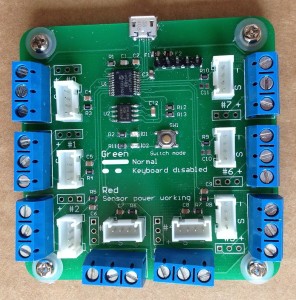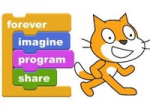6th Graders:
Block programing with Physical computing –Sixth graders started the year building their Scratch programming skills. Scratch is a programming language designed by the Lifelong Kindergarten group at MIT. Some of the skills the students have worked toward mastering include: sensing, conditionals (if/then statements) and variables. We then proceeded to add a physical computing element to the student-designed programming projects. Physical computing, in the broadest sense, means building active and interactive systems that can sense and respond to the world.
In this unit, the 6th grade students worked in teams to design an
arcade game that interacts with the physical world using basic circuitry to communicate to the computer. These projects are not quite finished, however, students have been enthusiastic about incorporating their programming into actual games made out of cardboard, wires, tin foil, and springs. Lessons from: Level 4 Scratch and MakeyMakey. (Changed curiculum from The Silk Road 2014)
Electronics The second part of the year the students have been exploring electrical circuits. They are using a variety of tools including electrical conducting playdough, multimeters, LEDs, sewable electronics resistors, soldering, and switches.
Students have the opportunity to be creative by determining the ways in which they will incorporate a variety of technical components into personally designed technical project. These projects are required to have some aspect that lights up and many of them incorporate movement. Students must determine how to use the electrical circuitry in order to activate motors and lights.
Curriculum Each lesson will include hands on activity box and suggestions for how to use the concept toward a longer term project. Final Project: Students will design a “flashlight” using common household materials other projects will be accepted if approved in advance.
7th Grade
 Physical computing with Make!Sense –The first half of technology class for the year focused on adding a physical computing element to the student-designed programming projects. Physical computing, in the broadest sense, means building active and interactive systems that can sense and respond to the world.
Physical computing with Make!Sense –The first half of technology class for the year focused on adding a physical computing element to the student-designed programming projects. Physical computing, in the broadest sense, means building active and interactive systems that can sense and respond to the world.
In this unit, the 7th grade students worked in teams to design a project using a variety of sensors including heartbeat, moisture, temperature, infrared, accelerometers, and potentiometers (devices for measuring electric potential). The sensors were connected to a MakeSense! micro controller (mini-computer) to control the students’ projects which were designed using the Scratch Programming language from MIT Media labs.
Curriculum: Make!Sense physical computing 16 session classMake!Sense physical computing 16 session class.
Project share:
MakeSensePub from Deb Ashman on Vimeo.
8th grade – TBD
combining programing and electronics. some sort of device that allows block programing and electronics. Or web page creation.
